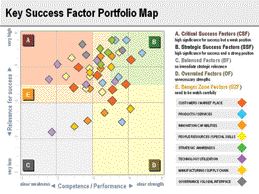
News
Key Success Factors: A Guide for Prioritizing Performance Improvement Effort
July 1, 2006 By Pulp & Paper Canada

Unfortunately, some organizations distill this important concept to a few motherhood statements such as: “being in the lowest quartile of costs,” “rewarding exceptional performers,” “partnerships with…
Unfortunately, some organizations distill this important concept to a few motherhood statements such as: “being in the lowest quartile of costs,” “rewarding exceptional performers,” “partnerships with key customers” and “high performance innovation.” The insights derived from a broad-based audit of needed key success factors often remain hidden, and consequently priorities in the organization’s competitive focus can be misplaced. A simple questionnaire-based audit covering a wide range of potential success factors can not only tap perspective from the whole organization but also highlight areas where effort towards improved competitive performance should be directed.
A generic list of key success factors [KSFs] for an industry sector can fall into eight categories [see table]; within each category there might be up to 10 factors. In any given organization there will be additional factors to supplement the generic list.
– KSF Category
* Sample factor
– Customers and market place
* Intimate customer knowledge
– Products and services
* Low-cost product design
– Innovation capabilities
* Continuous flow of innovation and improvement
– People resources and special skills
* Ability to attract and retain key people skills
– Strategic awareness
* Ability to anticipate industry trends
– Technology utilization
* Ability to adapt supplier technologies
– Manufacturing and supply chain
* High utilization of fixed assets
– Governance and global interface
* Meeting unique needs of emerging markets
By scaling each factor for, a] relevance with respect to overall competitive success, and b] internal performance or competence, a scorecard can be created for sharing and discussion [see figure]. The key success factors portfolio map sets out the relevance for success verses competence / performance. There are five zones [critical success factors, strategic success factors, balanced factors, overrated factors and danger zone factors] that identify targets for attention and action. In the example shown, most factors related to products and services [blue diamonds] are in the B zone and are therefore strong contributors to competitiveness. However, many of the factors related to technology utilization [purple diamonds] are in the critical red A zone and would therefore demand priority attention. There are also some factors with a weak relevance for competitive success [the D zone], but where internal competencies are indicated. This represents unnecessary strengths and probably a source of wasted effort. For added insight, an influence analysis of the relevant factors might be conducted to provide a priority and time line for follow-up performance improvement projects.
Why is this important?
A key success factors audit enables an organization to recognize priority areas for improved competitiveness and to create a shared vision for what needs to be done. A key success factors audit also provides a means of measuring internal variances of opinion by engaging various contributors to the audit questionnaire. With access to relevant external data, it may also be possible to benchmark with competitors. A “future” component may be incorporated to reflect assessments of competitive needs in future business scenarios. Primarily, such audits provide a means to engage and motivate the whole organization towards improving competitive capability. Key questions:
* Are we satisfied as an organization with our current performance?
* What are the key factors for success in our current and future business environment?
* Where should we be focusing our efforts for improvement?
* Is our whole organization aligned for tackling critical success factors?
Alan Procter is an international consultant and facilitator for “creative solution” workshops. He can be reached through www.alanprocter.com
Print this page